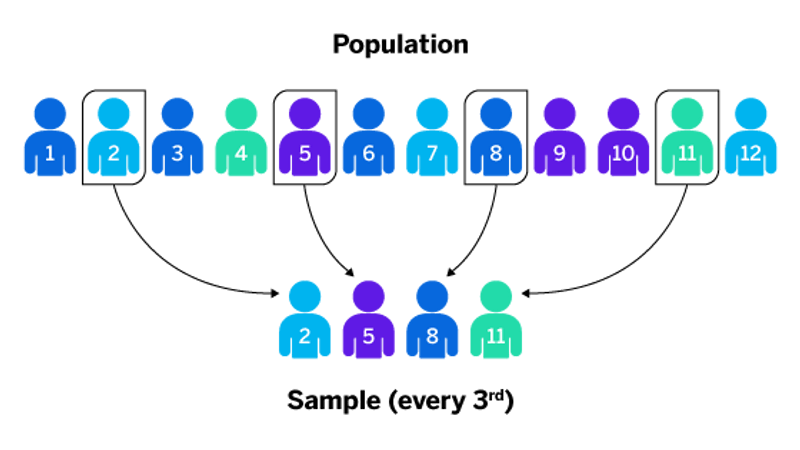If you want to zero in on a target population to uncover specific information, but need a simple, easy-to-use but highly effective (and accurate) method for doing so, systematic random sampling can help.
In this article, we’ll highlight what systematic random sampling is and how you can use it to create random sampling surveys to get a clear understanding of a target population.
What is systematic random sampling?

Systematic random sampling is also known as a probability sampling method in which researchers assign a desired sample size of the population, and assign a regular interval number to decide who in the target population will be sampled.
The sampling interval is then decided by dividing the population size by the sample size.
For example, if you had a list of 1,000 customers (your target population) and you wanted to survey 200 of them, your sampling interval would be one-fifth. This means that you would sample every 5th person in your list of 1,000 customers.
To ensure a random sample, researchers typically use a random start, e.g. a number within the range of the sampling interval. So you might start with the 2nd name in the list and then sample every 5th person (e.g. 2, 7, 12, 17 and so on).
Free eBook: How to minimise sampling and non-sampling error
Benefits of systematic sampling
There are several benefits to using a systematic sample for research, including:
It’s simple to use
Due to the way systematic sampling is structured, surveys based on it are easy to create and analyse.
While it’s thought systematic sampling can remove some of the unpredictability out of a sample, potentially resulting in data manipulation, this risk is very slight. This is because the only random component of the sample is the selection of the first person.
After that, the selection process moves in a pattern until the desired group is ready.
For example, in a population of 21, using a sampling interval of 3 would result in the numbers 3, 6, 9, 12, 15, 18, and 21 being used. It’s also important to ensure that your list is not ordered in any way that could introduce bias, e.g. if your list was ordered male, female, male, female, and you picked every other person, you would introduce a great degree of bias.
This type of sampling is particularly beneficial where the budget is limited as the sample selection process is straightforward.
It provides some control over the process
While systematic sampling retains an element of randomness, it also introduces some control and process into the selection process.
It’s low risk
Systematic sampling carries a low-risk factor because there’s a low chance that the data can be contaminated. This is because of the even distribution of members to form samples.
It reduces bias
Researchers have no control over who gets selected for systematic sampling. The selection process is truly random, creating a buffer against favouritism when it comes to data collection.
Limitations of systematic sampling
Although there are significant advantages to systematic sampling, it can carry some risks that you need to be aware of.
These include:
An assumption that the population size is known
Probability sampling requires that every sample member has a known, non-zero likelihood of being selected. If the true population size is not known and cannot be determined, then it is impossible to determine the sampling interval or likelihood of being selected.
Another challenge is that it can be difficult to achieve the desired sample size if the true population size is not known in advance. If you need a sample of 200 people, you may not know whether to sample every 5th person or every 10th person.
However, a systematic sample can still be conducted when the population size is not known in advance. For example, imagine you wanted to conduct an exit poll after an important election. Although you do not know in advance how many people are going to show up at the election site, you can choose to sample every 5th person who leaves the voting location between when it opens and closes.
The true population size will then be approximately 5 times your sample size.
You need randomness in the population
While it’s not common, if the population you’re assessing naturally possesses a standard pattern (e.g. the list is ordered male, female, male, female), it can remove the randomness of the sampling interval and inadvertently lead to an unrepresentative sample such as all males.
For example, let’s say you were surveying a high school class and wanted to select half of the students for an assessment. If the students were seated in a boy, girl, boy, girl pattern and your sampling interval was an even number, you could end up with all boys or all girls in your sample.
To avoid this, make sure your data is sorted in such a way that won’t introduce any kind of repeating pattern in the data — for example, you could ask the children to line up in order of height. That removes any repeating pattern (e.g., boy, girl, boy, girl) that might interfere with the systematic sample. If you had an electronic list of students in the class, you could sort the list in a random way such as alphabetically by student’s first name.
Determine your perfect sample size with our free Determining Sample Size Guide
Higher potential for data manipulation
While systematic sampling is reliable and contains a natural degree of unpredictability and randomness, it can lead to manipulation by individual researchers.
The method the researcher chooses for their sample collection could potentially result in a higher chance of achieving a predetermined outcome, rather than using simple random selection.
How to perform systematic random sampling

Let’s run through the steps for systematic random sampling:
1. Confirm the population total
It’s easier to achieve the desired sample size when you know the total population of the sample in advance. Once you have this number, the rest of the sampling process is simple.
2. Determine your sample size
When you know the size of the sample you want to draw from the population, you can establish the interval needed to achieve the desired sample size from the population.
There are several factors to consider when determining sample size, including population size, the margin of error (confidence interval), and budget.
For example, you may desire a sample size that yields a margin of error of +/- 5 points, or maybe it’s determined by your budget, e.g. you’re giving out £10 gift cards but can only afford 200.
Find out more about calculating your sample size.
3. Determine your sampling interval
For this, you simply divide the total population by the sample size. If the total population size is not known in advance (for example, if you’re conducting an exit poll during an election), then estimate the population size based on historical data (e.g. the previous election) to determine your sampling interval.
4. Select your random start
Starting your selection at a random number helps to retain the randomness of your selection and removes the risk of cluster sampling or manipulation. The random start number will be between 1 and the sample interval.
For example, to get a sample of 100 out of 1,000, you would select every 10th person.
5. Add your sampling interval until you have the desired sample.
Continue choosing your sample members at regular intervals until you have the sample size you need to complete your study.
Systematic random sampling use cases and examples
Example of a simple random sample
Let’s say a sample size of 20 out of a population of 100 is required.
For this study, each member of the population is assigned a number from 001 to 100.
Then, using a random number generator, 20 people are chosen for the research with each person having an equal probability of being chosen.
How to use systematic sampling
To achieve our 20 people, we choose one seat to determine where our sample starts.
We first calculate the sampling interval by dividing the total number of people in the population (100) by the number we want in the sample (20). This gives us a sample interval of 5.
We then select a number between 1 and the sampling interval from a random number generator. Let’s say we get 4 — this is where we start. We count down the list (using linear systematic sampling or circular systematic sampling) from our starting point (person 4) and select each 5th person.
For example, if we start at 4, the next would be 9, 14, 19, 24, 29, and so on. When you reach the end of the list, you should have your desired number (20) for the sample size.
Should you use systematic sampling or simple random sampling?
In each sampling method, every person has an equal chance of being chosen.
It’s also possible, however, that both methods could create some bias — e.g. a larger percentage of females selected than in the population despite a random selection process.
The primary reasons to use a systematic sample are (1) when the population size is unknown in advance (e.g. an exit poll during an election) and (2) it’s easier to conduct because you don’t have an electronic list or you need to sample on the go. For example, with a systematic sample, you select 1 out of every 5 people that enter a waiting room at a hospital.
Want to learn more about other sampling methods?
Choosing the right method for sampling your target audience can make all the difference when it comes to the reliability of your data and analysis. Of course, while a systematic random sample has its advantages, e.g. when the population size is unknown or you need to sample on the go, there are other sampling methods as well.
In our guide to sampling methods and best practices, we explore other probability and non-probability sampling methods, including stratified sampling and cluster sampling, convenience sampling, quota sampling, and more — all to give you the information you need to conduct comprehensive research.
If you want to learn more about sampling methods, you can read our ultimate guide to sampling methods and best practices.
At Qualtrics, we specialise in providing solutions that empower everyone to gather research insights and take action. With Qualtrics CoreXM, you can make sophisticated research simple.
Whether you’re in marketing, product, HR — with CoreXM, you can rapidly turn insights from surveys into actionable strategies.
Featuring advanced and incredibly flexible survey tools, built-in intelligence (driven by iQ), a fully automated platform, and research services, CoreXM enables you to run the surveys you need to get answers to your most important marketing, branding, customer, and product questions.
Want to know more? Book a demonstration.
Start conducting your own research with a free Qualtrics account